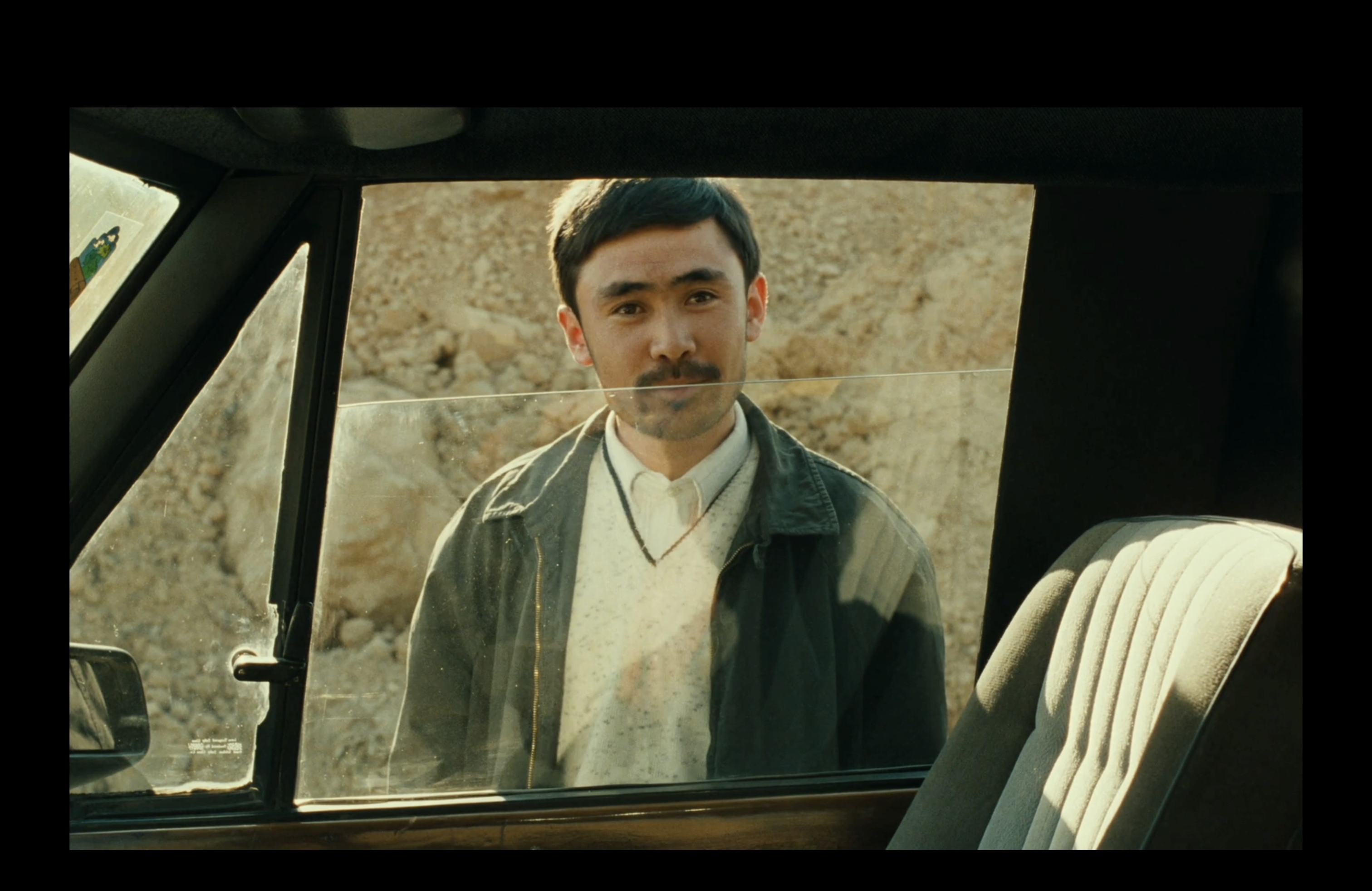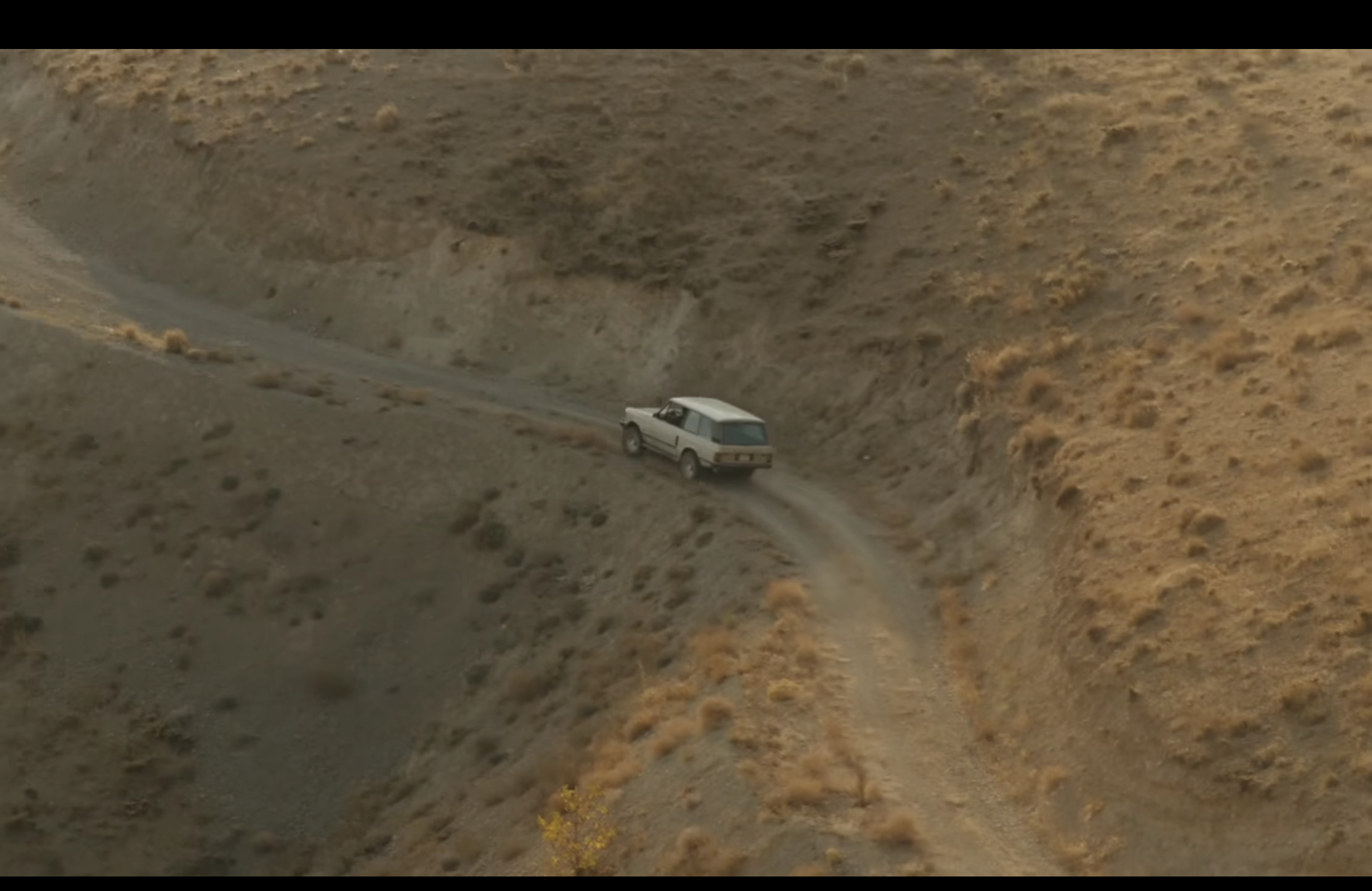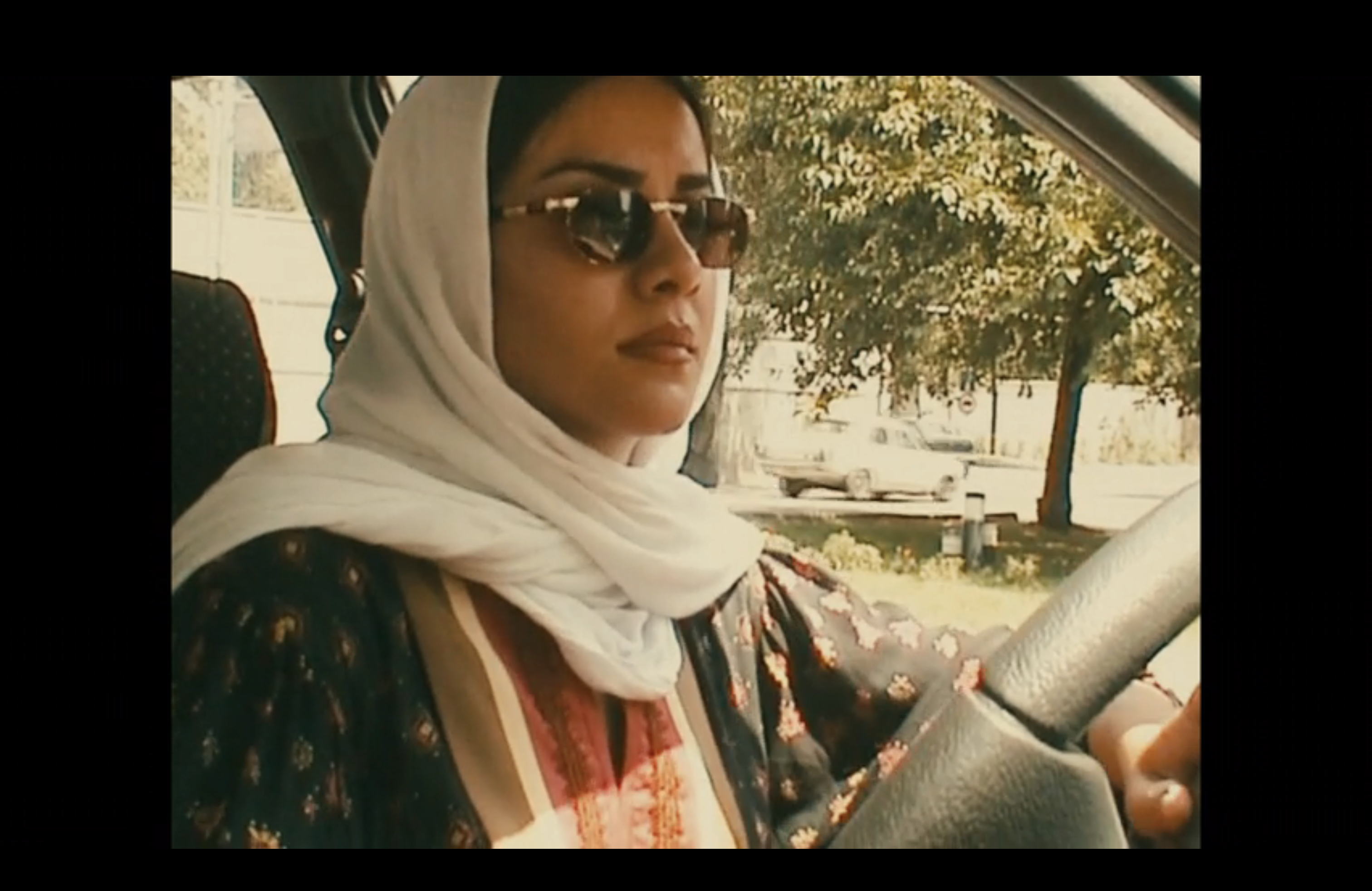The following is a post by Sedi Blachford, an undergraduate student at Brown University with an interest in Iranian cinema and Persian studies.
The three images above bear striking similarities. Each holds a face in the foreground framed by the outline of a car window capturing a blurred snapshot of Tehran. The drivers gaze passively into the distance, their eyes fixed on something out of view with their hands lying casually on the steering wheels as they navigate busy city streets. They exist on the boundary between private and public spaces, enclosed in the protection of rolled-up windows. The stills come from three films; Jafar Panahi’s Taxi, and Abbas Kiarostami’s Taste of Cherry, and Ten. In each film, a storyline unfolds almost entirely within the confines of a vehicle, a common trope in contemporary Iranian cinema. The structural device of a driving narrator conjures a liminal space between public and private where personal narratives collide with the hostility of censorship and social regulation.
Cars hold a particularly significant place in the everyday lives of urban Iranians. They provide not only the general necessities of travel and transport, but serve as a symbol of independence and liberation. Models like the famed Paykan that dominated Iranian streets for decades are repositories of political history and collective memory. First introduced in the late 1960s, the Paykan has served as a tool for social mobility. However, the vehicle’s place in society shifted with the changing political atmosphere. The car’s role as an instrument for economic and physical freedom transitioned into one of political respite.
As state censorship tightened in the post-revolutionary era, vehicles became increasingly important as portable spaces out of the public eye. The comfort of a pair of upholstered seats allows for conversations to stay safe behind a wall of traffic, without isolating the driver and passengers from the outside world. The importance of cars in the collective experiences of urban Iranians makes it a popular narrative device among filmmakers. They provide a useful backdrop to let audiences in on private moments while allowing a story to unfold out in the open.
Jafar Panahi’s 2015 film Taxi uses the car as a vessel to offer a self-aware critique of censorship in the film industry and across the Iranian political landscape. The film is a work of “docufiction” in which the director poses as a taxi driver and picks up people around the city. From the first two passengers bickering about crime to his niece who candidly explains the guidelines for film censorship with a smile spread across her cheeks, each passenger acts as a representative of different limitations of life in contemporary Iran.
In 2010, Panahi was banned from filmmaking and traveling outside of the country on grounds of political dissent. His films since then have tackled issues of censorship and government overreach head-on. Driving a taxi allows Panahi to traverse the outside world while still highlighting his confinement. Within the semi-permeable walls of his vehicle, Panahi bears witness to conversations that overtly or implicitly critique the state.
The dual function of the car as a safe space and as an extension of Panahi’s captivity emphasizes Iran’s unique political atmosphere. Despite state repression and surveillance, political discourse persists in semi-public places like taxi cabs. The pressure to self-censor is not so severe as to limit free conversation in moments of relative privacy. The audience is locked in the car alongside Panahi, but can still observe the delicate coexistence of critique and repression.
Panahi emphasizes the interplay between censorship and reality when Hana, his young niece, argues with a boy on the street about picking up a fifty toman note that fell out of a man’s pocket. Hana is attempting to make a movie for a school project that will be distributable under the guidelines laid out by her teacher. She aims her point-and-shoot camera outside the car window, giving the viewer a frame-in-frame image as the boy stoops to grab the note. When Hana confronts him, she implores him to return the money in order to protect her film’s moral message. She argues that she won’t be able to use the footage if it shows him stealing, which will ruin her project. In this moment, her sense of right and wrong is governed not by her own belief system, but rather by what will be viewed as acceptable by others.
Within the car’s confines, Hana can decide which aspects of the outside world she wants to feature. In this way, the vehicle acts simultaneously as a space safe from censorship and a tool for creating a selective narrative. Hana is filming reality, but she is also trying to direct it to fit the ideal of what is presentable handed down to her through her school. The car’s private space allows her to discuss with Panahi the restrictions she’s working within, while her interactions with the world outside pass the seeds of self-censorship on to those around her. Hana’s directorial intent in her film exemplifies the car as a permeable space, where the characters are in constant conversation with the larger social order.
In Abbas Kiarostami’s Taste of Cherry from 1997, the vehicle is less an overt political statement and more of a tool to mark self-imposed psychological isolation. The film follows Mr. Badii as he drives around Tehran searching for someone who will bury him if he commits suicide. The film features an austere emotional landscape with tightly-scripted dialogue punctuated by long silences.
Unlike Panahi’s Taxi, the camera is not locked into Badii’s car, and the film often cuts to sweeping panoramic shots that accentuate Badii’s isolation as he drives through the hills surrounding Tehran. The subject matter of the film is unavoidably taboo, as suicide is not only culturally unacceptable but also illegal in Iran and prohibited in Islam.
When Badii attempts to convince a seminarian he picks up off the side of the road to bury his body, the man implores him to reconsider his decision to commit suicide and refuses to assist him. As he parts with Badii, the young man invites him to share an omelet, but this stranger’s kindness is not enough to dissuade him. Badii declines, remaining in the familiar world of his driver’s seat. His car is an extension of himself; a miniature world he can manipulate through half-opened windows and turns of the steering wheel.
Badii never reveals exactly why he wishes to end his life, but it is clear he is affected by some ambiguous suffering that even he struggles to articulate. His Range Rover acts as a vessel for his desperation which cannot be spoken of or expressed beyond the car’s four doors. Badii’s vehicle provides him with a sheltered private space under his control where he can express himself without the pressure of public exposure.
However the car’s role is not restricted to being a repository for Badii’s depression. Badii’s use of his vehicle as an accomplice to his illicit intentions complicates the car’s role as a backdrop. The vehicle is no longer purely a container for the story. Rather, Badii’s dusty Range Rover plays an active role in his plan while functioning as a portable representation of his consciousness protected against public scrutiny.
The use of the car in Taste of Cherry highlights how vehicles are spaces where the laws and practices of everyday life can fade into the background. What seems like a ludacris and deeply taboo plan in open society suddenly becomes accessible when Badii is behind a steering wheel. It is the relative privacy provided by the car’s four doors that permits him to navigate the public space around him despite his psychological distress.
The film Ten, released in 2002, uses the car as a social and political space to turn the focus inwards onto familial, religious, and gender dynamics. The film features a series of ten vignettes, each of which holds an emotion-laden exchange between a single female driver and different passengers.
Although Abbas Kiarostami is credited as director, the lead actor Mania Akbari claims her involvement in the film was misrepresented and concealed by Kiarostami and that the footage comes directly from her. In some ways, Akbari’s many years of silence on the extent of her involvement in the film for fear of retribution mirrors how the driver in Ten’s conversations are trapped within the confines of her vehicle.
Ten is often cited as a direct inspiration for Panahi’s film Taxi, and there are certainly similarities in the cinematography. Both films are shot with cameras that lie exclusively within the vehicle, although the camera in Ten is more observational and less interactive than Panahi’s dashcam. Like Taxi, Ten uses the driver’s car as a backdrop to hold conversations that require privacy. For the driver, these conversations consist of private details on family matters like love, sex, and divorce. Ten does not attempt to shy away from the struggles and inequity the female protagonist faces.
The film’s casual dialogue and simple structure give it a documentary-like style which fits well with the everyday drama that plays out between the driver and her passengers. The film candidly interacts with the world outside of the car, with the driver often gesturing to other drivers or remarking on traffic and roadblocks. The inclusion of these interjections binds together the chaos of the interior of the car and the exterior of the city to create constant reminders of the world through which the driver is traveling.
Within the confines of her car, the driver feels no need to self-censor as she yells at her son about her divorce and asks a passenger who is a sex worker candid questions about pleasure and love. Her level of camaraderie with her passengers is a reminder that the issues of gender inequality she grapples with are openly discussed parts of everyday Iranian life, even if they are not always visible at the official level. In the opening scene, the driver and her son get into an impassioned argument over her divorce from his father. Her young son begs her not to shout as she yells at him about the plight of unhappy married women. He seems worried that others might hear her, but his mother disregards his complaints.
For the driver in Ten, her car is the ultimate symbol of freedom. Not only does it allow her to move about the streets independently and make a living, it also gives her a space to speak loudly and at length about the difficulties she’s subjected to as a woman and to connect with other women she meets. With her two hands firmly on the steering wheel, she is in control despite the chaos unfolding around her. The car empowers the driver to speak her mind without fear of retribution as she navigates the outside world.
In Taxi, Taste of Cherry and Ten, the car acts as a powerful narrative tool framing every interaction. Driving places power in the protagonists’ hands as they navigate both the physical world around them and the social and emotional worlds within the vehicle. The interplay between the outside world and the interior of the car is a constant reminder of the fragility of these spaces: they are always liable to be attacked and intruded upon.
In the twist ending of Panahi’s Taxi, the camera resting on his dashboard is stolen by a man clad in all black. Although the conclusion is ambiguous, it is implied that the man was a government agent sent to steal the camera’s memory chip. This conclusion plunges the audience into darkness and shatters the image of the taxi as an idyllic private space. It points to the constant tension between public and private that the car embodies. As with the panning shots in Taste of Cherry, and the driver’s hand gestures out the window in Ten, the final moments of Taxi reinforce cars as permeable spaces which the characters must work to maintain. Privacy is not only valuable, it is deeply vulnerable and must be protected.
The context of censorship and social taboos in Iran strengthens the meaning of the car doors as boundaries. But these films were not created to be anthropological studies of behavior under an oppressive government, and they speak to the relationship between cars and social freedom more broadly. The prevalence of the car in these acclaimed films reveals how privacy is often a prerequisite for personal exchanges. Along with governing Iran’s cultural landscape, issues of censorship and social regulation are unavoidable in cinema. Whether films tackle restrictions on free expression head on or with nuance, the vehicle acts as a constant reminder of the fragile boundary between public and private.


















